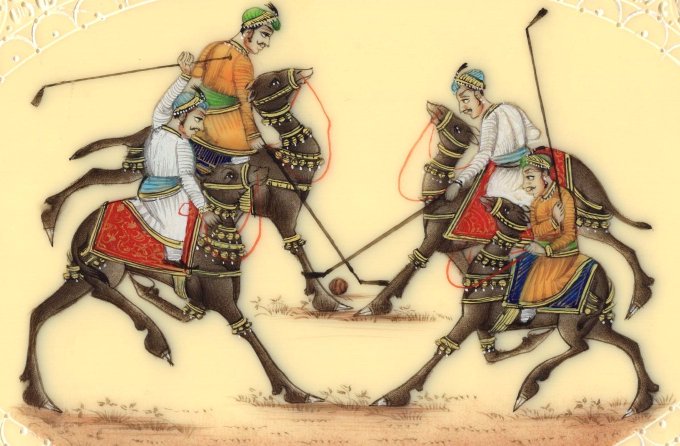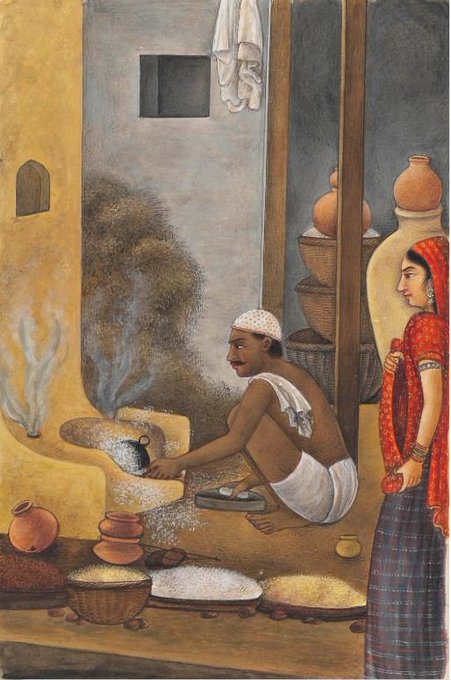RajasthanのTwitterイラスト検索結果。 289 件中 8ページ目
A very Large Map of Pilgrim Sites along #Ganges #YatraPatha, from #Jaipur #Rajasthan 18th C. On cotton, yellow ground painted with palaces, temples, villages & place names inscribed in devanagari, elephants & tigers shown.
59in x 42ft
@ChristiesInc sold it for GBP156500
@iamrana
Maharaja Procession Grandeur
#Maharajah #RajasthaniPainting #IndianArt #Procession #Handmade #ArtnIndia
Rao Raja Bhoj Singh of #Bundi #Rajasthan Batters a Leaping Tiger from a Tree, 17th century #Rajasthani school of art painting now in @harvartmuseums depicting a popular mode of Hunting. A sheep is tied to a tree as a bait as the hunter waits atop a 'Machan' to use his match lock.
In the company of Birds
#RajasthaniArt #Maharani #Queen #IndianPainting #Handmade #ArtnIndia #Portrait #Ethnic
A kind of #blue
Jeffrey Becom
Orvieto, Italy
Kalymnos, Greece
Jaisalmer, Rajasthan, I
Chaouen, Morocco
Pungi or Been Musician
#ArtnIndia #Handmade #RajasthaniPortrait #IndianMiniaturePainting #SnakeCharmer #Pungi #Musician
Rajasthani Maharaja & Elephant
#IndianMiniaturePainting #Handmade #ArtnIndia #RajasthaniArt #Maharajah #Elephant #Mahut #Decor #Asian
Sanitizer after pedicure?
Rajasthan 17th century
@dpanikkar @DalrympleWill @PunjabiRooh @hemantsarin @PropitiousOn3 @ambrin_hayat @WhiteMughalsFan @shada_islam @SmitaRays @SupriyaJaan
The Jaipur Maharajah King
#Maharajah #RajasthaniArt #Handmade #IndianPainting #ArtnIndia #Jaipur #Decor #Asian #WaterColor
rudra and gaNesha: pratIhAra; Rajasthan. The lions suggest there were probably other figures like rudrANI
Maharajah's Camel Polo
#IndianMiniatureArt #RajasthaniPainting #ArtnIndia #Handmade #WaterColor #Decor #Polo #Maharajah
As the #Rajasthan FD prepares 9 #greatindianbustards for rehabilitation, let's give them the cheer they deserve. GIB was also included in Appendix 1 of the #copcms13
From my column with @the_hindu : https://t.co/EOqgXbnRGd
#EndangeredSpecies #birds #cartoons
A bony ascetic (?) preparing bhang, seated in a landscape, a parrot perched on his turban
Kishangarh c.1780. pic courtesy Bonhams #Art #History #Rajasthan @DalrympleWill @JAJafri @ssharadmohhan @dpanikkar @PunjabiRooh @MedhaviGandhi @KulbeliTweets @ResearchLife92 @PropitiousOn3
New artwork for sale! - "Village girls Rajasthan" - https://t.co/9uZzTIQ1uK @fineartamerica
#Rajasthan's #sambharlake witnessed mass bird deaths from #botulism and elevated concentrations of salt from illegal salt mining in the lake this year. Applause for all veterinarians and organizations who teamed up to treat the birds
Cartoon from my column with @RGSustain1
Royal Camel Polo
#Polo #Rajasthan #IndianArt #ArtnIndia #Handmade #Painting
While we celebrate newborn girls by sending pink gifts, in the village of Piplantri in Rajasthan, India, they celebrate by planting 111 trees. Since 2006 the Piplantri village has planted more than 350,000 of trees each year in celebration of their girls. Source: @greatbigstory
Me, waiting for breakfast.
From @Sothebys this late 18th century painting from #Rajasthan or even #Mughal of a #European family at table.
The principle theme and artist are unknown. Nevertheless, it sold for £12,000.
@DalrympleWill @dpanikkar
A Bharbhunja couple ? The traditional occupation of the #Bharbhunja community is roasting & selling different types of grain like corn/maize & groundnuts. They are found in Uttar Pradesh, Rajasthan, Maharashtra, Madhya Pradesh, Chhattisgarh, Punjab, Haryana & Chandigarh. #History
Royal elephant named Khushi Khan. Left late 17th/early 18th cen. Khushi Khan has decorative orange markings on his forehead, temple & ear. Right late 18th cen. & based on the earlier work. Striking contrasting tones between the pale trunk & the black body #Art #History #Rajasthan







































